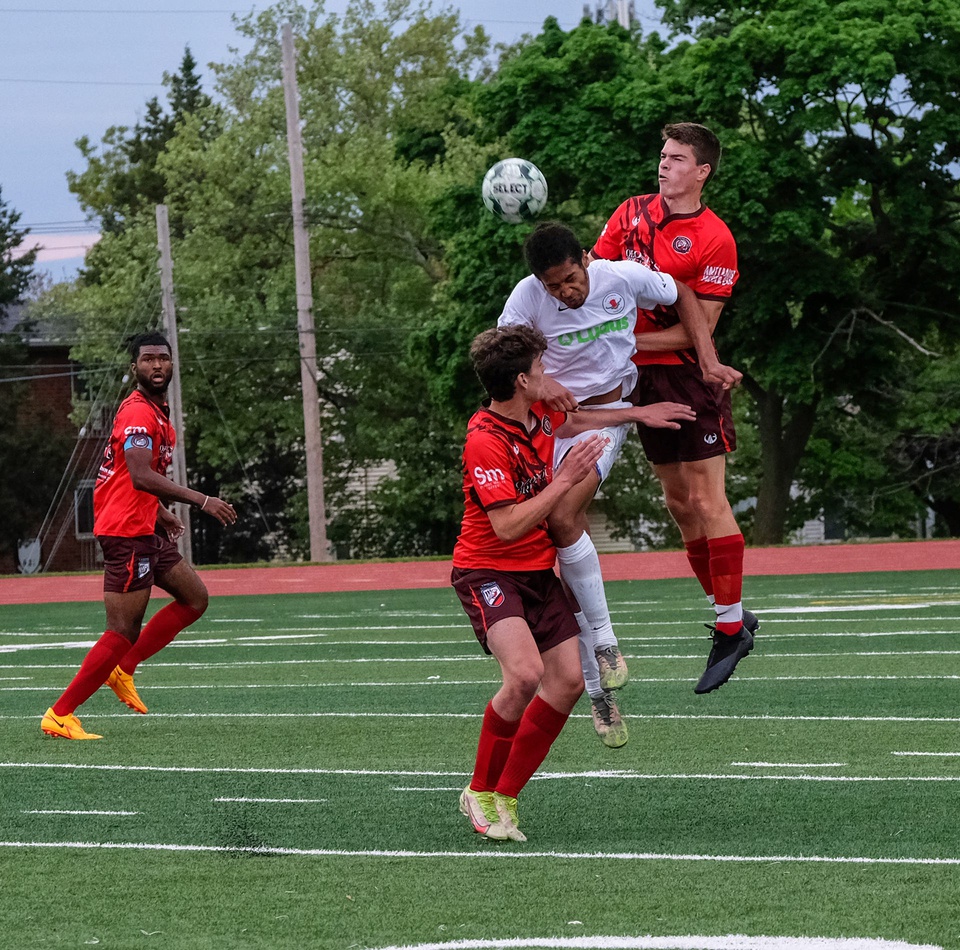The Midwest Premier League may have just caused a seismic shift in American soccer.
Ask any European football purist, and they’ll tell you that the promotion-relegation system is at the heart of competitive spirit. It makes leagues exciting, gives all teams something to play for. It evokes a plethora of emotions in players and fans, ranging from heartbreak to jubilation. And yet, the United States is different. Since the early days of American pro soccer (think NASL), the sport’s leagues have operated on a franchise basis.
Various efforts have been made over the years to bring pro-rel to the USA, but they’ve mostly been in vain. The Eastern Premier Soccer League (EPSL), an amateur league operating in seven East Coast states, succeeded in 2021. Other leagues, however, have been reluctant to do the same. On Friday, the first domino finally fell – the semi-professional Midwest Premier League (MWPL) announced that it would be bringing the acclaimed format to its part of the country for the first time, introducing it in the high-quality Heartland Conference. The effects of the decision on the American soccer pyramid could be monumental.
Midwest Premier League Sparks Revolutionary Change
What is the Midwest Premier League?
Founded in 2019, the MWPL had its inaugural season in 2021. It’s a regional league comprised of top amateur and semi-pro clubs from seven different states. Since its inception, the MWPL has seen rapid expansion, with 35 teams competing in 2023, compared to 20 just two years earlier. Further expansion has occurred ahead of the 2024 season, which will kick off in May. The league is currently divided into four conferences, based on geographical location. Widely considered to be the most competitive is the Heartland Conference, which boasts 13 teams from Illinois and Wisconsin as of 2024. Among these are well-known clubs such as Bavarian United SC and Chicago House AC.
Bavarian United is one of the oldest clubs in the United States, having played its first match in 1929. The Bavarians are six-time National Amateur Cup champions, most recently in 2022, and have been U.S. Open Cup mainstays throughout the competition’s history. Chicago House, meanwhile, have a much shorter, but very impressive history. Established in 2020 by famed soccer magnate Peter Wilt (a fervent pro-rel supporter), the House competed in the professional third-tier league NISA in 2021. The club ultimately restructured as semi-professional and joined the MWPL in 2022. In 2023, they reeled off five straight wins in the Open Cup, only losing to MLS side Chicago Fire in the third round proper. No non-professional team advanced further in the competition than the House. Interestingly, they could only manage a third place finish in league action that same year, a testament to the quality of the Heartland Conference.
Where does Pro-Rel Come In?
Rumors of a promotion-relegation format have existed since the MWPL’s inception. In 2021, the organization entered a strategic partnership with NISA, the only professional league in North America that supports the pro-rel movement. NISA’s long-term plan for inter-league mobility revolves around its national semi-pro league, NISA Nation, as well as its regional partners. While there isn’t any official U.S. Soccer designation of leagues below the third tier, NISA Nation can be considered a fourth-tier league. This would in turn designate the MWPL and other NISA partners, which include the pro-rel EPSL, as fifth-tier. In an ideal world, a streamlined pyramid would allow for promotion and relegation across the three tiers. Such a system would certainly transform the country’s soccer landscape. However, NISA has been engulfed in persistent controversies and has an ever-wavering corporate structure. These issues continue to stall the proposed upheaval.
Introducing the 𝟐𝟎𝟐𝟒 𝐇𝐞𝐚𝐫𝐭𝐥𝐚𝐧𝐝 𝐂𝐨𝐧𝐟𝐞𝐫𝐞𝐧𝐜𝐞!
Beginning this season, the Heartland will be a 𝙩𝙬𝙤-𝙙𝙞𝙫𝙞𝙨𝙞𝙤𝙣 𝙘𝙤𝙣𝙛𝙚𝙧𝙚𝙣𝙘𝙚 🔃
Read more here: https://t.co/mm8pLtyawV pic.twitter.com/hXa6jltedq
— Midwest Premier League (@midwestpl) February 23, 2024
For the time being, the MWPL has taken matters into its own hands. First off, it announced the MWPL 2030 Plan in October 2023. In an official statement, the league described the plan as “a road map for a future tiered system that will feature promotion and relegation.” In other words, by 2030, the aim is to have a blanket pro-rel structure across all conferences. The plan stipulated that some changes could occur “as early as 2025.” Less than a month after the introduction of MWPL 2030, however, the clubs of the Heartland Conference launched a joint proposal to the league, asking that pro-rel be implemented for the 2024 season. It seems the league and its clubs have beaten themselves to the punch.
How Will Things Change for the Midwest Premier League?
On Friday, the proposal was accepted. For the first time in Midwest soccer history, a professionally-affiliated league will have promotion and relegation. Starting in 2024, the MWPL Heartland Conference will consist of two divisions with mobility between the two. This year, six teams will compete in Division 1 and seven teams will compete in Division 2. According to the league, the initial alignment is based on “sporting merit and all-time results in the league.” Exactly how many teams will be promoted or relegated annually has not yet been specified.
Division 1 is nothing short of an all-star league as far as Midwest soccer goes. Bavarian United and Chicago House, for example, will compete in this league. So will Chicago giants RWB Adria, a historic club founded by Croatian immigrants in 1959. Adria has made five separate appearances in the Open Cup proper and is a nine-time Illinois State Cup champion. A third Chicago team will also compete in Division 1. Czarni Jaslo, a Polish-run side, only joined the MWPL in 2023, but ran away with the conference title in their first season. They lost just once all season and finished four points ahead of Adria in second.
Finally, two smaller-market teams round out the division: DeKalb County United (DeKalb, IL) and Steel City FC (Joliet, IL). Both are renowned for their passionate fanbases and incredible community outreach, leading to widespread popularity. Additionally, the two clubs have a knack for attracting top talents to their squads, often staging giant-killings against big city clubs. Predictably, these small-town sides have a feisty rivalry amongst themselves, with intense battles both on the pitch and on social media.
What’s The Reaction Been Like From Club Executives?
Steel City FC
The announcement of such a drastic change to the league structure has caused a ripple through the Midwest Premier League. Ivaldo Basso, the Chairman of Steel City FC, spoke exclusively to Last Word on Sports on the matter. “We think semi-professional soccer should be exciting,” says Basso. He lauded the league’s decision, saying it will “add intrigue to the competition.”
Indeed, the Heartland Conference’s top tier is so packed with quality that Basso believes that “it’s not a stretch to say it may be among the toughest semi-pro circuits in the nation.” Along with being the head of Steel City, Basso also serves on the MWPL Board of Directors, meaning he was directly involved in the switch to pro-rel. He, like most involved with the league, seems thrilled to finally see the idea come to fruition.
DeKalb County United
Greetings from the top division. Lovely view up here. Can see all the way to Milwaukee. https://t.co/AVinCZvcte
— DeKalb County United – Protect The Cup (@dkcunited) February 23, 2024
In addition to Basso, LWOS reached out to John Hall, President of DeKalb County United and former President of the MWPL. Hall shares Basso’s sentiments, stating that DKCU is “thrilled at the opportunity to compete with the best our conference has to offer.” He does note that the club’s perspective changes with the threat of relegation now looming. “There’s only one objective in the league in 2024 – stay up.” Hall also praises the league administration for “balancing all the challenges of managing a member-run league,” while noting that the 2030 Plan is far from a new concept. He says it was in the works during his tenure as league President, and that the 2024 format change is “just the start of some really cool things for [the league].”
As for what could happen on a larger scale, Hall says that he’d hope to one day see a “full amateur soccer pyramid under the guidance of USASA.” Whether this will ever happen is a big question, but with two major amateur leagues now operating at least partially on a pro-rel basis, the door is open. However, a semi-pro to professional jump is highly unlikely in the US. That being said, a blanket adoption of pro-rel by the USASA could potentially lead US Soccer to impose something of the sort amongst the three tiers it oversees.
Edgewater Castle FC
It’s perhaps unsurprising that the clubs named to Division 1 of the Heartland Conference have reacted so positively to the recent news. But what about the teams in Division 2? Edgewater Castle, a non-profit club out of Chicago, is one of three sides that have effectively been relegated. And yet they too speak highly of the league’s format change. Club Director Tom Arnison notes that the new division will “certainly be competitive,” especially when considering the “element of surprise” that the four new expansion teams will bring.
That being said, ECFC have no interest in sticking around. “The top division is where we want to be and where we believe we are capable of playing,” says Arnison. This is a sentiment that Edgewater’s fellow Division 2 teams will likely share. With the second tier consisting of just seven clubs, everyone’s in the running for promotion. The new season will produce no shortage of excitement.
A Major Step Towards an Important Goal
🏴☠️Promoted!
Welcome to Wrexham? Hold our Malört. There’s a promotion story in your backyard!
The Midwest Premier League has adopted promotion and relegation, and we will play in the circuit’s first division!
We earned top slot by being the third-highest points earner through… pic.twitter.com/OPghg9wug8
— Steel City FC (@Steel_City_FC) February 23, 2024
The Midwest Premier League is semi-professional, far below the glitz and glamor of MLS and USL, making it easy to view this news as minor or even unimportant. But just because it’s easy doesn’t mean it’s right. The league’s decision does much more than one might imagine.
Logically, it will drastically affect the Midwest soccer landscape. Beyond that, though, the MWPL’s pro-rel format sets a national precedent. The movement is finally gaining traction in the US. The EPSL got the ball rolling in 2021, and the MWPL is keeping it moving in 2024. It’s hard to imagine that this will be the extent of it. More change is to be expected in the coming years. Bit by bit, organization by organization, region by region, American lower-league soccer is healing. And regardless of whether you’re a fan, a player, an executive, or a journalist, you have to admit – it’s a wonderful sight.
Photo Credit: Robert Killips | Lansing State Journal / USA TODAY NETWORK, of a Lansing Common Headshot and a Tulip City Headshot, on May 21, 2022.






